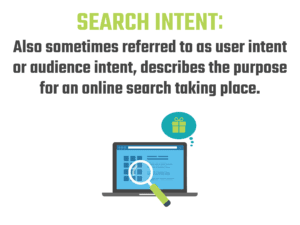The practice of SEO (Search Engine Optimization) is growing ever more comprehensive as the programming and algorithms behind search engines become cleverer and more complex.
At the heart of this all is the need for search engines to present the most relevant possible search results for users, and it’s this that they base all of their systems and processes around.
Search intent forms the basis from this and from there, all efforts are focused.
What is Search Intent?
Search intent, also sometimes referred to as user intent or audience intent, describes the purpose for an online search taking place.
The reason that anyone conducts a search online likely dictates the most appropriate results for it. For example: is the user looking for information? Do they want to make a purchase? Are they searching for a particular brand name and only that website will do? The user’s search intent is the ‘why’ behind the action being completed.
The Four Types of Search Intent
There are four primary types of different search intent, each with its own purpose. These are:
Informational
Those conducting informational searches are looking to find some specific information. These searches are often, but not always, framed as questions, with informational keywords, and can be simple or fairly complex. Searches made with informational intent include those such as:
– What is the capital of Morocco?
– Directions to London Luton Airport
– How does blockchain work?
– How do you say hello in Mandarin Chinese?
Navigational
A search made with navigational intent is done to find a specific website or web page. The user already knows where they want to go but either don’t know the URL to type in directly to the address bar or find it quicker or easier to search for it instead with navigational keywords. Searches made with navigational intent include those such as:
– Peugeot official website
– LinkedIn login
– BBC news headlines.
Transactional
A user searching with transactional intent is looking to make a purchase and in many cases, already know what it is they’d like to buy and are looking for a retailer to buy it from. Searches made with transactional keywords include those such as:
– Buy MCFC kit
– Newest iPad cheap
– John Lewis coupon
– Zoom pro subscription.
Commercial Investigation
When a user is searching with commercial intent, they are also looking to make a purchase but have not yet decided which specific product or service they’re going to buy. This is part of the user journey online ahead of a transactional search, and may find the user searching for reviews and comparisons as they seek to make an informed purchase decision. Searches made with commercial investigative intent include those such as:
– Best vegan eyeliner
– Macbook Pro review
– Plumber near me
– Trustpilot vs Feefo.
Why is Search Intent Important?
Google’s number one goal is matching search intent of their users with relevant search results, in order to ensure they are providing as accurate and appropriate search result pages as possible, to continue their reign as the most successful search engine in the world.
When content on a website is properly tailored toward an audience’s search intent rather than simply whatever message it is the business wants to convey, they are able to meet their user’s needs by satisfying search intent: demonstrating relevancy, authenticity and helpfulness to Google’s algorithms. These factors all feed into the overall SEO ranking and are likely to boost the position of the webpage, as well as increase conversions and time spent on the domain as well as lowering bounce rate.
Realistically, if a business isn’t able to adapt and create content to meet the needs of user’s search intent, they’ll find that they’re unable to cater appropriately for their target audience, and that audience will move to other online domains, including likely those of their competitors.
How to Identify Search Intent
Search intent can often be identified through the language used in the search. For example, the word ‘buy’ is only likely to be present in a search made with transactional intent, and ‘how to’ in a search with informational intent.
Generally speaking, you can determine the search intent behind a search if it includes the following language:
Informational intent: who, what, where, when, why, how, guide, tutorial, resource, ideas, tips, learn, examples.
Navigational intent: brand name, product name, service name.
Transactional intent: best, good, top, review, testimonial, comparison, product attribute (such as colour/size/specific feature).
Commercial investigative intent: buy, coupon, voucher, order, shop, purchase, price, cheap.
Of course, this isn’t necessarily accurate at all times dependent on the exact phrasing of the search, but it forms a good guideline. If a business is using a keyword research tool they may be able to filter relevant search terms by intent.
Google’s Guidelines on Search Intent
Google has provided exact guidelines on search intent and how webmasters can and should understand and work with it. These are known as the Google Quality Raters Guidelines.
Google employs quality raters who conduct search queries online before rating how appropriate and accurate the results they are served with were for their search intent. The guidelines that inform these raters highlight the importance of search intent along with the different types of intent and the impetus that Google puts onto intent, but explains that intent may vary between location, time and device.
For example, a search for a supermarket on a mobile device is likely to be a user looking for a nearby location, but on a desktop or laptop computer is more likely to be intended for an online order. When the search is made early in the morning or late at night, it’s more likely to be an enquiry for opening hours. The intent varies based on the way in which the search is made.
All of this signifies the prestige that Google holds behind user search intent, and how it builds its algorithms and systems around it to meet these needs. This includes the introduction of the Google BERT update in 2019 which focused on natural linguistic programming to inform the search engine of the intent behind the search and help more accurately convey appropriate results.
How to Optimise to Meet Search Intent Needs
Businesses can best analyse and optimise their digital presence to meet user search intent needs through collaborative working with an SEO specialist. At Woya Digital, we have a team of SEO expert professionals in-house who analyse business’ web presence entirely bespoke: taking on each job as an individual entity and never applying a one-size-fits-all approach.
We can help you meet the needs of both your potential and existing customers online through content optimisation to meet the needs of their search intent – raising your organisation’s profile, rank and success online all at the same time.


